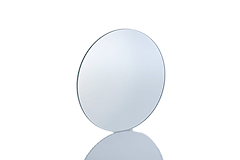

Bespoke Ordering Available

At Knight Optical, we supply a diverse array of potassium chloride optical components, including precision windows and ground blanks.
Our products are designed to meet a broad potassium chloride wavelength range, ensuring optimal performance in your applications. We cater to your specific needs by providing both uncoated and coated options, featuring broadband antireflective (BBAR) coatings.
Potassium chloride (KCl) is a crystalline material often used as a sputter window in CO2 lasers. Its wide transmission band means it has extensive optical applications across various wavelengths, making it suitable for UV, visible, mid-wave, and far-IR regions. This adaptability underscores its importance in potassium chloride optics uses.
If your requirements extend beyond our standard range, our technical sales team is ready to assist. We continually expand our capabilities to meet the evolving demands of the optical industry, ensuring we can provide solutions specifically for your potassium chloride wavelength and refractive index requirements.

Speak to our experts about your Custom Potassium Chloride needs today
Call +44 (0)1622 859444Make a quick enquiry about Custom Potassium Chloride Now
Dive into the forefront of optical solutions. Got questions about an optical product? Reach out now and let our expertise guide you.
Optical Properties of Potassium Chloride
Understanding the critical role of potassium chloride’s refractive index in optical performance, we ensure our components meet strict quality standards. Our in-house metrology laboratory, equipped with state-of-the-art technology, allows us to guarantee that your potassium chloride optics align with your exact specifications.
For those exploring potassium chloride optics uses in various industries, including scientific research, medical devices, and defence systems, Knight Optical is your trusted partner. Our commitment to quality and our ability to provide custom solutions make us an ideal choice for your optical needs.
Below is a brief summary of potassium bromide’s optical properties.
| Transmission Range | 0.21 to 20µm |
|---|---|
| Refractive Index | 1.45644 @ 10µm |
| Density | 1.99 g/cm3 |
| Melting Point | 776°C |
| Hardness | Knoop 7.2 <110>, 9.3 <100> with 200g indenter |
| Diameter | < 5mm to 80mm |
|---|---|
| Form error (@633nm) | < 0.25 waves |
| Centration/parallelism | < 1 arc minute |
| Scratch/dig | < 40/20 |
| Typical coatings | BBAR @ 1-20µm, DLC @ 1-20µm |
Frequently Asked Questions
-
What are the common uses of Potassium Chloride in various industries?
-
Potassium chloride (KCl) is widely used across different sectors. In the optical industry, KCl was once employed for infrared optics but has been replaced by more durable materials. However, it’s still used in some specific optical applications like Fourier-transform infrared spectroscopy (FTIR). Beyond optics, KCl is a fundamental component in medicine, food processing, as a salt substitute, and in agriculture as a fertilizer component. It’s also employed in scientific applications and as a flux in glass manufacturing due to its clarity-enhancing properties.
-
Why is Potassium Chloride important in optical applications?
-
Although its use has declined due to hygroscopic issues (meaning it absorbs moisture), KCl was historically used in infrared optics for its wide transmission range from UV to far-infrared light. Nowadays, KCl might still be used in FTIR spectroscopy applications as it allows for the efficient transmission of infrared light. However, care must be taken to protect KCl components from moisture to prevent degradation.
-
How does the wavelength range impact Potassium Chloride’s use in optics?
-
The effectiveness of potassium chloride in optical uses, especially in spectroscopy, is largely due to its broad transmission range, from 210 nm to 20 µm. Potassium chloride’s wavelength is suitable for various spectroscopic techniques and CO2 laser applications, though its hygroscopic nature limits its long-term use unless it’s properly protected or used in controlled environments.
-
What are the refractive index and key optical properties of Potassium Chloride?
-
KCl’s low refractive index makes it an ideal candidate for use in certain optical applications, such as CO2 laser applications and infrared spectroscopy, where low absorption and high damage thresholds are crucial. However, the exact value of the refractive index and how it influences optical performance should be considered in the design of optical systems.
-
Where can I find Potassium Chloride optics for sale, and what factors affect their cost?
-
Potassium Chloride optics, like windows and lenses for infrared applications, can be purchased from specialized optical manufacturers and suppliers. The cost can vary based on the size, thickness, and quality of the material, as well as the current market supply and demand for KCl. For specific dimensions and customisations, prices will vary. Contacting suppliers directly for quotations is advised.
-
What are the specific applications and benefits of using Potassium Chloride optics in scientific research?
-
In scientific research, KCl optics are mainly used in FTIR spectroscopy and other infrared-related applications. Their main benefit lies in their broad infrared transmission capabilities, making them suitable for analyzing a wide range of materials. However, due to their hygroscopic nature, their application is more suited for short-term projects or environments where moisture control is possible.
Is your question not here?
We are ready and waiting to answer any queries you may have about germanium.
Additional Information
Growth
Potassium chloride is grown via the Kyropoulos method , and cleaves easily. It is slightly more durable than potassium bromide but its transmission does not extend as far in the IR region.
Considerations
Safety
KCl is extremely soft so care needs to be taken when handling. It is also very hygroscopic so needs to be kept in a moisture-free environment., or a protective coating should be applied to the exposed surface.

Get in touch with us:
With our in-house state-of-the-art metrology laboratory you can be confident that your optical components will meet your requirements. You can find out more about our testing facilities here.

Operating for over 30 years
Knight Optical has been operating for over 30 years, with our managing director Colin Overton at the helm. Over this time, we have become a global leader in the production and distribution of scientific optical components and bringing quality into focus for all of our products and services that we provide.
Our Catalogue
Inside Knight Optical’s catalogue you’ll find details of the industries we serve as well as the many other services we can offer. It also showcases hundreds of our most popular products, supported by useful technical information, to help you choose the right part for your application.
Click below to view our digital catalogue now.

